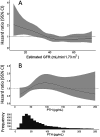Risk factors for hip and vertebral fractures in chronic kidney disease: the CRIC study
- PMID: 38477777
- PMCID: PMC11262146
- DOI: 10.1093/jbmr/zjae021
Risk factors for hip and vertebral fractures in chronic kidney disease: the CRIC study
Abstract
Fracture risk is high in chronic kidney disease (CKD) and underlying pathophysiology and risk factors may differ from the general population. In a cohort study of 3939 participants in the chronic renal insufficiency cohort (CRIC), we used Cox regression to test associations of putative risk factors with the composite of first hip or vertebral fracture assessed using hospital discharge codes. Mean age was 58 years, 45% were female, 42% were Black, and 13% were Hispanic. There were 82 hip and 24 vertebral fractures over a mean (SD) 11.1 (4.8) years (2.4 events per 1000 person-years [95% CI: 2.0, 2.9]). Measured at baseline, diabetes, lower body mass index (BMI), steroid use, proteinuria, and elevated parathyroid hormone (PTH) were each associated with fracture risk after adjusting for covariates. Lower time-updated estimated glomerular filtration rate (eGFR) was associated with fractures (HR 1.20 per 10 mL/min/1.73m2 lower eGFR; 95% CI: 1.04, 1.38) as were lower time-updated serum calcium and bicarbonate concentrations. Among time-updated categories of kidney function, hazard ratios (95% CI) for incident fracture were 4.53 (1.77, 11.60) for kidney failure treated with dialysis and 2.48 (0.86, 7.14) for post-kidney transplantation, compared with eGFR ≥60. Proton pump inhibitor use, dietary calcium intake, measures of vitamin D status, serum phosphate, urine calcium and phosphate, and plasma fibroblast growth factor-23 were not associated with fracture risk. In conclusion, lower eGFR in CKD is associated with higher fracture risk, which was highest in kidney failure. Diabetes, lower BMI, steroid use, proteinuria, higher serum concentrations of PTH, and lower calcium and bicarbonate concentrations were associated with fractures and may be modifiable risk factors.
Keywords: PTH/Vit D/FGF23; biochemical markers of bone turnover; fracture prevention; fracture risk assessment; osteoporosis.
Plain language summary
People with chronic kidney disease are at high risk of fractures. Our research assessed the relationship between several patient characteristics and the risk of fractures in 3939 patients with chronic kidney disease. We found that the following characteristics were associated with a higher risk of a hip or spine fracture: having diabetes, lower body mass index, use of steroid-containing medications, lower kidney filtration rate (“eGFR”), higher amounts of protein spilled in the urine, lower calcium and bicarbonate levels, and higher parathyroid hormone levels. Future studies should assess if improving these characteristics decreases the risk of fractures in patients with chronic kidney disease.
© The Author(s) 2024. Published by Oxford University Press on behalf of the American Society for Bone and Mineral Research. All rights reserved. For permissions, please email: journals.permissions@oup.com.
Conflict of interest statement
None declared.
Figures

References
-
- Pimentel A, Ureña-Torres P, Zillikens MC, Bover J, Cohen-Solal M. Fractures in patients with CKD - diagnosis, treatment, and prevention: a review by members of the European Calcified Tissue Society and the European Renal Association of Nephrology Dialysis and Transplantation. Kidney Int. 2017;92(6):1343–1355. 10.1016/j.kint.2017.07.021 - DOI - PubMed
Publication types
MeSH terms
Substances
Grants and funding
LinkOut - more resources
Full Text Sources
Medical
Research Materials
Miscellaneous

